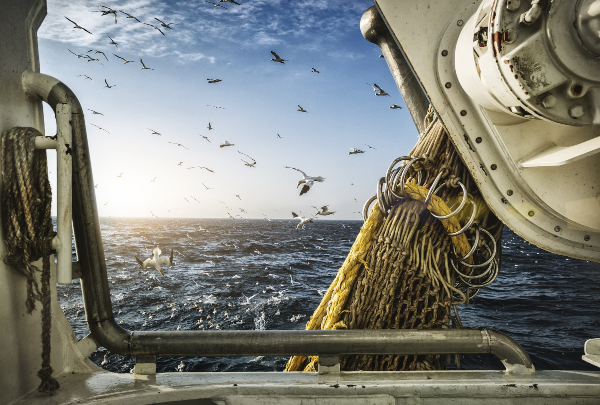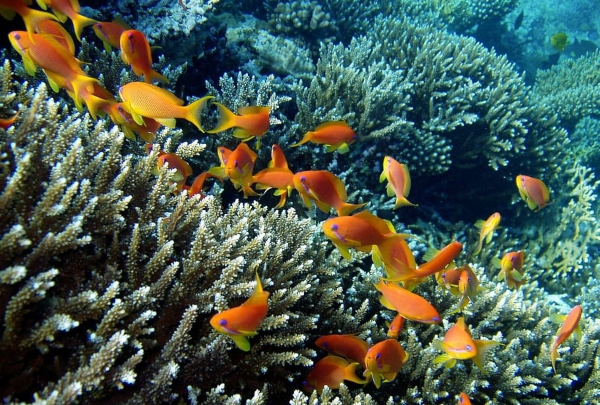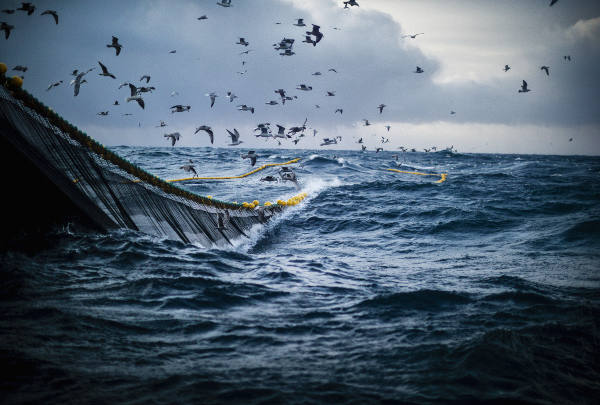Interview
Manuel Barange: “34% of fishing resources are overexploited, but 79% of market fish comes from sustainable resources”

Manuel Barange, director of the FAO Fisheries and Aquaculture Policy and Resources Division since 2016, has just published the SOFIA 2020 report, an eagerly anticipated study on the state of world fisheries and aquaculture.
How has Covid-19 impacted fisheries and aquaculture’s socio-economic situation?
The impact is and continues to be, in some countries, considerable. You must bear in mind that fishery and aquaculture are extremely dependent on other industries such as food services, restaurants, hotels, etc., whose activities have come to a complete standstill. The drop in demand has caused a drop in prices, as a result of which fishermen, who have had to adapt their activities to protect their health and keep social distancing, have suffered additional losses.
The food processing industry has also been affected, both by falling demand and by the difficulty of operating with health protection measures. Added to the closing or near closing of markets, airports and ports, the industry has collapsed in many places. In the Mediterranean, for instance, at one point 90% of fishing boats were not operating.
Has there been any initiatives to mitigate these consequences?
Yes, of course there has been a variety of measures in each country with different origins. Some countries have applied support measures – covering part of the salaries of those with formal contracts (who are not the majority in the fishing industry, particularly in developing countries), delaying licence payments, temporary tax reductions, etc.
In most cases, the measures apply to the entire food industry because food supply chains have to be reactivated urgently. The FAO is working, in particular, with the World Bank to support specific industry measures. You have to bear in mind that one in every four food industry jobs is at risk as a result of the pandemic, and this could take us back 10 years in the fight against hunger.
Value chains have to be reactivated urgently, because most fishermen don’t have the financial capacity to weather this storm without support.
What state are the world’s oceans in today?
Let’s say that right now, all political, economic, environmental and social eyes are on the oceans, and we all have an opinion based on our individual point of view. Politically, the oceans have attracted renewed interest because of the dichotomy between the freedom of access to the seas and the need to protect common ocean goods. Economically they are seen as an opportunity for development, environmentally, people perceive the risk to their integrity and beauty, and socially there is great awareness, partly because the ocean is visually incomparable.
As a UN official, my obligation, as someone said, is to make hope possible rather than despair convincing. I can see challenges, opportunities and step-by-step work for the expectations of some and the fears of others to end up converging.
You’ve just published the SOFIA 2020 report you’ll be talking about in your Meeting of the Seas talk. Can you share any findings with us now?
I’ll give you three headlines. First, in 2018 (the last year of available data in the SOFIA report) global fishery and aquaculture volumes reached a record high and, in consequence, each of us now consumes 20.5kg of fish a year, more than double the per capita consumption in the 1960s. Second, in the places where resources are managed intensively, with the support of science, management, control and monitoring, they are increasingly sustainable and growing in volume. However, in places where they aren’t, resources are deteriorating and as a result, they are failing to provide the food and nutrition they could. Third is the consequence of all this, 34% of fishery resources (in number) are overexploited, but in terms of volume, 79% of the captured fish that reaches our markets come from sustainably exploited sources.
What policies are being implemented in Europe to promote sustainable fisheries and aquaculture? What about safeguarding the health of our seas?
The EU manages marine resources through the Common Fisheries Policy. In the last 10-15 years, this policy has been very effective in overturning a situation which prior to 2000 was extremely negative.
Currently, most captured fish species in Europe are exploited sustainably, although there is a lot of room for improvement. The exception is the Mediterranean, which according to SOFIA continues to be the area in the world with the lowest sustainability index (<40%).
European organisations and the General Fisheries Commission for the Mediterranean (GFCM) are hard at work to revert this trend, but we must bear in mind that the Mediterranean has 21 coastal countries with varying degrees of poverty, inequality, political instability and conflicts. The lack of peace, hunger and poverty are devastating for sustainability.
Are these policies effective?
I will add two things. First, the EU’s environmental policy is among the most ambitious with respect to the seas and oceans, but unlike the fisheries policy, its implementation is still in its infancy. Second, we’ve not said anything about climate change, which is an added risk in terms of resource management. Not only because the yield of some resources will decrease as a result, but also because the yield of others will increase, and in many cases we don’t have any sustainable management measures for these “new” species. Sustainability is like a never-ending marathon – the fight is constant, and sometimes it’s successful and others it isn’t.
What measures can ensure sustainability? What would be the right procedures or protocols? How can we manage aquatic resources sustainably?
The SOFIA report and the work of the FAO and others over decades are extremely clear: sustainable fisheries resource management is possible. Management measures based on proven scientific evidence and effective institutions and political support do work. At the FAO, we say that management is the best conservation measure. Because first and foremost, the right management measures are conservation measures – closed fishing areas or periods, minimum sizes, limited use of certain methods, etc. all of these are conservation measures. Second, because in places where management fails, because of a lack of political will or efficient institutions, it is difficult for any conservation method to prosper, for the same reasons. In fact, management measures can be a great driver of long-term conservation, in particular if the communities concerned are part of the solution and not an “innocent bystander” who only endures the negative consequences of decisions made by others.
What are the main species produced by world aquaculture? Will the sea be the pantry of the future?
Aquaculture has been the fastest growing food segment in the last decade, and there’s still a lot of room for further growth, particularly in Africa. The industry has grown by 5.3% per year since the turn of the century, although this percentage is decreasing as the total volume grows. Thirty-nine countries that account for 50% of world production already produce more through aquaculture than capture fishery, although no European country is among them. The development of aquaculture in Europe is extremely limited, for complex reasons including social opinion, political will and cross-industry conflicts.
What species are the most farmed? Several species of carp and tilapia are those we produce more, but they are freshwater species. Marine aquaculture produces about 31 million tonnes every year, generating almost 110bn dollars in revenue. Most are molluscs (mussels, oysters), salmon and shellfish (prawns). Although we farm more than 600 types of aquatic species in the world, production is highly concentrated on a limited number of species.
One question remains and it is quite legitimate. Where is the food we need to feed 10bn people going to come from? The ocean has to be part of the answer. It makes up 2/3 of our planet’s surface and it produces a very small amount of food. But if we want to increase production volumes, we have to take sustainability into account.
What are current marine products consumption figures in Europe? Is it decreasing compared to other countries? Why? What are current consumption trends?
All continents consume more fish today than in the 60s, for example, including Europe. But European consumption has suffered a small downturn in the last 4-5 years, so has North America, while other continents have continued upwards. It is difficult to read anything into this data without addressing the trends of other protein alternatives, in particular meat. But globally, we are expecting consumption per capital to keep increasing to 21.5kg by 2030, one kilo more than today, regardless of population growth. In fact, fish consumption has grown well above population growth in recent decades, but meat consumption also follows a similar trend.
What percentage of the population currently works in fishery? Has it changed a lot in recent years? Is aquaculture a growing activity?
We estimate that 60 million people work in the primary sector of fishery and aquaculture, of which aquaculture accounts for 20 million. But if we consider the secondary sector (processing, market, etc.) this figure c
an be multiplied by two or three, although the exact figure is difficult to ascertain because national statistics don’t separate food processing data by segment.
As a whole we believe that 10% of the human population relies on fishery, including the families who depend on it for livelihood.
Could aquaculture help resolve poverty and provide food for the world’s growing population?
Of course. It is an area of significant innovation and development, and 90% of production is in Asia, so it has an outstanding capacity to transfer effective practices where hunger and malnutrition are rife. We have to develop aquaculture if we want to feed the planet sustainably.
What are the conclusions of the SOFIA 2020 report?
I’m going to give you two, because in this interview I’ve already given you a few. The first, is that we must put more emphasis on the sector’s social sustainability. Work in the fishery industry is extremely hard, profits are limited and it doesn’t appeal to young people, and we’re not making enough efforts to appreciate the role of women in it today and as a driver of future change. Not everything is about the economy and the environment. The second is that there’s no alternative to sustainability. I mean that no matter how difficult it seems, sustainability is our holy grail, an endless thorny path where the processes and mechanisms must follow strict rules – to put the emphasis on science, to accept that there are different views about what is or isn’t sustainable and to respect the institutions and processes that have proven effective.







